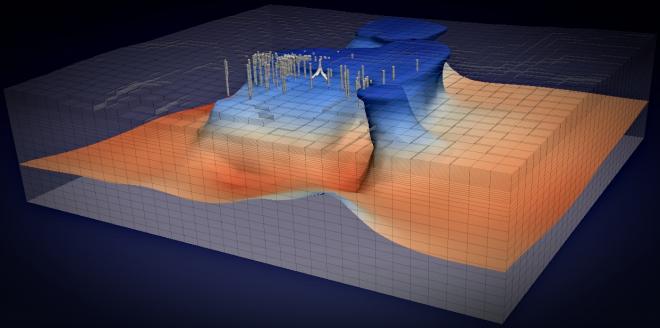Next-gen geothermal modelling for a cheap green energy future
The Challenge:
New Zealand’s geothermal energy suppliers need next-generation software to sustainably extract geothermal energy.The Solution:
University of Auckland researchers are using NeSI resources to build the Waiwera geothermal reservoir simulator. This simulator handles large numerical models of geothermal liquid and gas flows.The Outcome:
Waiwera has reduced months of computation time to less than a day. It’s a future-proof software designed for parallelised computation and large flow models. It will go on to help engineers around New Zealand and the world to manage geothermal sites.
New Zealand sits above a vast reservoir of geothermal energy. In 2017, geothermal power provided 17 percent of New Zealand’s electricity demand. It’s one of the cheapest sources of new energy generation available.
This is thanks to New Zealand’s proximity to the Taupō Volcanic Zone. But tapping into geothermal energy comes with unique challenges. Energy suppliers need numerical models to help them sustainably harvest geothermal energy.
Water, heated beneath the Earth and turned into steam, provides energy to geothermal plants. Electricity suppliers need to model the movement of this water and steam beneath the Earth, so they can tap the best points for geothermal energy. They also need to know how the system will behave when a large-scale geothermal plant begins operation. If they extract too much steam, they could deplete the reservoir.
Dr Adrian Croucher is an engineering science researcher at the University of Auckland. He used NeSI computing resources to develop the Waiwera geothermal reservoir simulator.
“Much of our work is modelling existing geothermal fields. We’re looking at how to manage these resources sustainably. The goal is to keep them producing energy for a long time.” says Adrian. “First, we model the natural state, what it was like before production began. Then we model production up to the present day, so we can mimic observable data. Then we can use that to model how the field will behave in the future. We create predictions to inform new infrastructure, like power stations. We’re trying to maximise output while keeping it sustainable.”
Adrian built Waiwera as a successor to the industry standard, TOUGH2 geothermal software. This software was created in the late 80s and wasn’t designed to handle huge modern numerical models. Adrian wanted Waiwera to be a better option for today’s largest geothermal models. He also wanted to make Waiwera future-proof, so engineers could use it for years to come.
To build Waiwera, Adrian used the PETSc library. PETSc is a scientific computation library full of tools that Waiwera uses to simulate flows. Adrian worked with both PETSc consultants and NeSI team members in a cross collaboration to optimise Waiwera.
“Use of NeSI was central to our software development. We don’t know how big models will get in the future, so we wanted to make this as scalable as possible. To do that you need access to a high-quality parallel cluster. These clusters are purpose-built for performing with large models. On substandard hardware we could still test scalability, but we wouldn’t know if our software was underperforming because of our hardware or our code.”
The AUTOUGH2 simulator is University of Auckland’s version of the industry standard TOUGH2 software. Adrian calculated that running one particular large-scale geothermal modelwith this software would take several months. But with Waiwera on NeSI's HPC platform, it took less than a day.
“NeSI was also vital because our testing required huge data sets. We needed real world data to build our models. Running multiple iterations of these data sets is beyond a desktop computer. To get results in any reasonable time frame we needed high-performance computing.”
Waiwera is open-source software, so it’s available for anybody to run. The energy industry is already engaging Adrian’s expertise and Waiwera to model future extraction sites and sustainable use.
As a cheap energy source, it could help cut down on New Zealand’s fossil fuel dependence and bring more green, cheap energy to New Zealand.
Do you have an example of how NeSI support or platforms have supported your work? We’re always looking for projects to feature as a case study. Get in touch by emailing support@nesi.org.nz.







